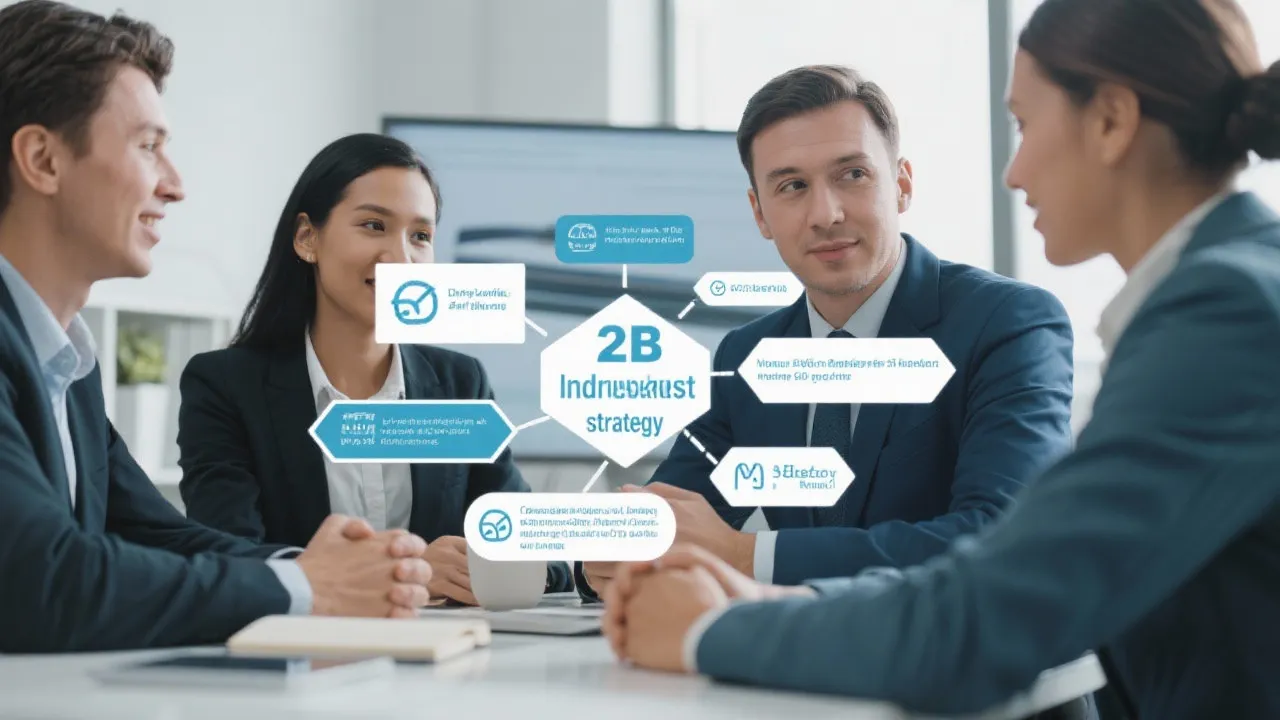Mastering Inbound B2B Strategy
The essence of Inbound B2B marketing revolves around attracting and engaging potential business clients through valuable content. This approach emphasizes organic growth by creating meaningful interactions, leveraging data-driven insights, and enhancing customer relationships. This article examines its strategic importance and practical applications in today's competitive market landscape.

Understanding Inbound B2B Marketing
Inbound B2B marketing is a strategic approach focused on attracting, engaging, and delighting customers through content and interactions that are relevant and helpful. Unlike outbound marketing tactics that often interrupt your audience, inbound marketing forms connections they are looking for and solves problems they already have. This method not only enhances the customer experience but also fosters a lasting relationship that can lead to repeat business. The crux of inbound B2B marketing lies in aligning your marketing efforts with your buyers' needs and behaviors, ensuring that you provide value at every stage of their journey.
The Significance of Inbound Strategy in B2B
In the Business-to-Business (B2B) arena, the complexity of decision-making processes and the longer sales cycles necessitate a focused approach. Inbound B2B methodologies play a crucial role in establishing trust and nurturing leads through strategic content creation and dissemination. The principles focus on authenticity, providing solutions, and establishing thought leadership, which ultimately leads to higher conversion rates. Importantly, B2B purchases often involve multiple stakeholders, each with their own concerns and priorities. Inbound strategies are designed to address these intricacies by delivering tailored content to the right people at the right time.
Moreover, the shift towards online research and decision-making in B2B has made inbound marketing even more pertinent. Business buyers conduct extensive research online before reaching out to a supplier, often spending more time at the consideration stage than ever before. By employing inbound tactics, companies can ensure they are present in the digital landscape when potential clients search for solutions.
Key Components of Inbound B2B Marketing
An effective Inbound B2B strategy encompasses several core components, each integral to the overall success of the marketing funnel:
- Content Creation: Crafting valuable, well-researched content that addresses the pain points of your target audience is foundational. This includes blogs, whitepapers, eBooks, infographics, and webinars aimed at educating and informing potential business clients. Well-crafted content not only showcases your expertise but also answers questions your prospects may be asking at different stages of their buying journey.
- SEO and Keywords: Optimization of content through strategic keyword placement, like "Inbound B2B," helps in improving organic reach and ensuring your content is discoverable to those seeking solutions you offer. It’s essential to consider search intent and long-tail keywords, as they might capture niche queries that can lead to high-quality leads.
- Social Media Engagement: Leveraging platforms like LinkedIn, Twitter, and even Facebook to distribute content, engage with industry peers, and nurture relationships. B2B companies should participate in relevant discussions forming connections and establishing credibility through sharing insights and engaging directly with their audience.
- Analytics and CRM: Utilizing customer relationship management tools and analytic platforms to monitor client interactions and measure the effectiveness of marketing tactics. This data can provide insights into customer behavior, preferences, and the effectiveness of various touchpoints, enabling marketers to refine their strategies for better outcomes.
Implementing Inbound B2B Strategies
Implementing a successful Inbound B2B strategy entails several practical steps, each contributing to a seamless customer journey and enhancing lead conversion:
- Define Your Target Audience: Conduct detailed market research to understand your ideal customer profiles and their specific needs. Building detailed buyer personas is essential as it guides content creation, SEO efforts, and overall marketing strategies.
- Create Tailored Content: Develop content that speaks directly to the challenges faced by your audience, offering insights and solutions that set you apart from competitors. This could include case studies that demonstrate successful implementations of your solutions, or guides that offer best practices that would benefit your target audience.
- Optimize Your Website: Ensure your website is user-friendly, informative, and responsive, with optimized calls-to-action that guide prospects along the sales funnel. Investing in UX/UI design can enhance user navigation, making it easier for potential clients to find the information they need.
- Utilize Automation Tools: Implement marketing automation to streamline processes and maintain consistent engagement with your audience. Automated emails, targeted drip campaigns, and lead scoring systems can nurture leads effectively, providing them with relevant content based on their behavior.
- Assess and Adjust: Regularly review your analytics to understand which tactics are very effective, and adapt your strategies based on data-driven insights. This evaluation should not only focus on lead generation but also on customer retention and satisfaction, ensuring that the inbound strategy contributes to long-term business relationships.
Comparing B2B Inbound Marketing with Outbound Approaches
| Aspect | Inbound B2B | Outbound B2B |
|---|---|---|
| Focus | Audience empowerment through informative content | Direct promotion and advertisement efforts |
| Customer Engagement | Interactive and leads-driven | Transaction-focused, often one-sided |
| Cost | Good, potentially lower cost buildup | High initial investment in ad space and media |
| Reach | Organic, can be wider over time | Limited to paid channels and existing contacts |
| Tactics | Focuses on valuable content, SEO, social proof, and engagement | Focuses on cold calling, email blasts, and banner ads |
| Long-term impact | Builds ongoing relationships and brand loyalty | Often leads to short-term gains with minimal relationship building |
Industry Trends and Future Directions
With evolving digital landscapes, B2B organizations are increasingly recognizing the value of inbound marketing frameworks. Innovations such as AI-driven analytics, personalized customer journeys, and integrated sales-marketing alignment are setting the pace for future trends. Companies embracing these advancements are likely to experience sustained growth and improved customer loyalty.
For instance, artificial intelligence can analyze vast amounts of data to predict customer behavior, allowing businesses to create hyper-personalized experiences that resonate with individual buyers. Additionally, automation tools enable real-time engagement with potential customers, delivering tailored content and offers based on user interactions. Voice search optimization is another trend that has grown in significance as more business professionals use smart devices to conduct research. Marketers need to ensure their content is easily accessible and optimized for voice search queries.
Moreover, as companies prioritize sustainable practices and corporate social responsibility, inbound marketing can highlight these efforts, building strong brand reputation and customer trust. Integrating storytelling into content strategy can help convey these messages effectively. Moving forward, the connection of marketing technology (martech) with sales processes will further streamline the customer journey, ensuring a seamless interaction that can enhance conversion rates.
FAQs on Inbound B2B Marketing
- What is the primary objective of Inbound B2B Marketing?
The main goal is to attract potential customers by providing them with valuable content and engaging experiences at every stage of their buying journey. This approach also emphasizes building relationships and trust, leading to long-term customer loyalty. - How does Inbound B2B marketing differ from traditional marketing?
Inbound B2B marketing is more about creating meaningful interactions and content that organically attract customers, rather than disruptive advertising methods. It focuses on providing value before making a pitch, which is particularly relevant in fields where customers prefer to do their own research before contacting a supplier. - Can small businesses benefit from Inbound B2B strategies?
Absolutely. Inbound marketing is particularly beneficial for small businesses as it leverages organic growth and enhances customer loyalty without the need for extensive advertising budgets. Small businesses can utilize their unique narratives and personalized service to capture the attention of their target audience effectively. - Which platforms are very effective for Inbound B2B marketing?
LinkedIn is particularly effective due to its professional nature, making it suitable for B2B engagement. Additionally, company blogs serve as a hub for valuable articles and resources that draw in potential clients and enhance SEO visibility. SEM-optimized content hubs contribute significantly to attracting organic traffic through well-structured content strategy. - How long does it take to see results from Inbound B2B marketing?
The timeline for seeing results can vary based on numerous factors, including the competitiveness of your industry, the quality of your content, and how well you optimize your strategies. Typically, businesses can expect to see initial traffic growth within 3 to 6 months, but it may take longer to see substantial lead generation or conversion improvements. - What role does content play in B2B Inbound Marketing?
Content is the cornerstone of inbound marketing. It drives engagement, generates leads, and nurtures prospects throughout the sales funnel. High-quality, relevant content that aligns with the buyer's journey can position your brand as a trustworthy authority, thus enhancing credibility and encouraging conversions. - Are there any specific metrics to track in Inbound B2B marketing?
Yes, metrics such as website traffic, conversion rates, lead quality, and customer acquisition costs are essential to evaluate the effectiveness of your inbound marketing efforts. Additionally, tracking customer lifetime value (CLV) helps determine how much revenue a customer generates over their entire relationship with your business, painting a clearer picture of your marketing success.
-

A Guide to Cost-Efficient Small Electric Cars for Seniors
-

Mastering Debt Consolidation: Boost Your Credit Score and Manage Interest Rates
-

Your Guide to Loans, Credit Checks, and Interest Rates
-

Affordable Independent Living: Finding the Right Senior Housing
-

Guide to Senior Living Apartments: Affordable and Comfortable Environments










